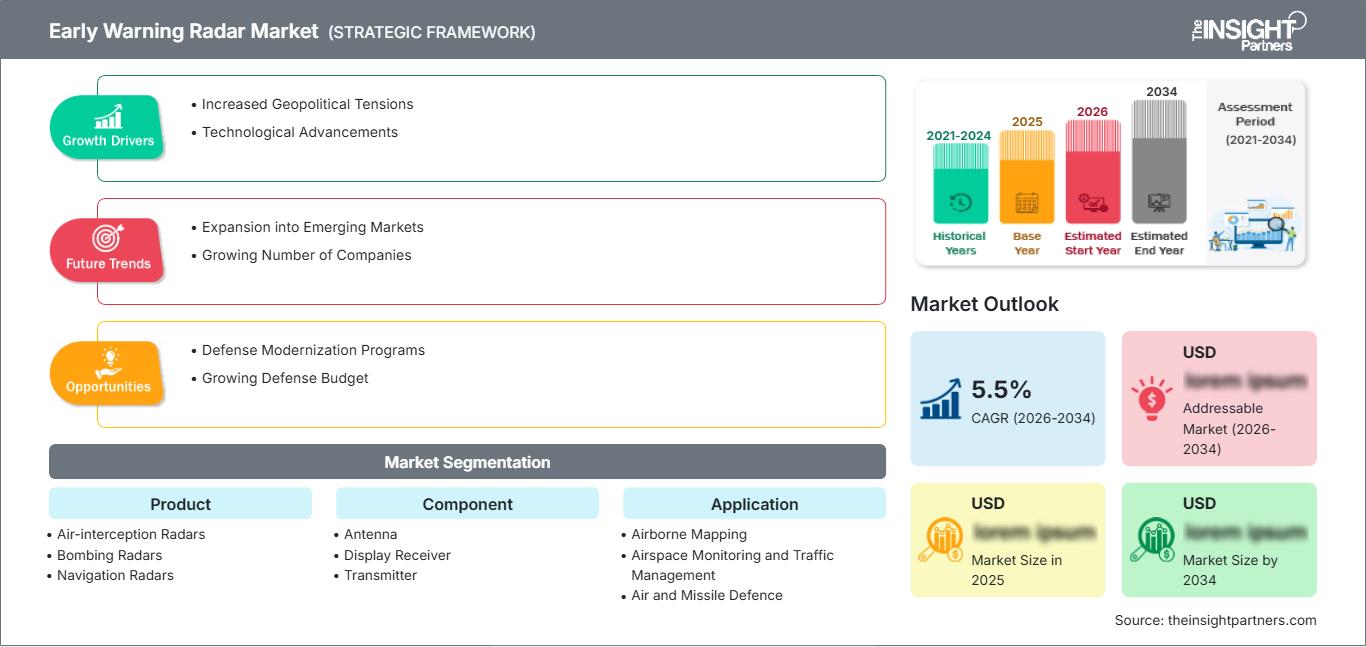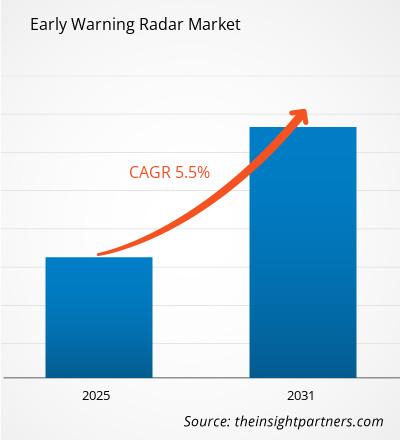Si prevede che il mercato dei radar di allerta precoce crescerà a un CAGR del 5,5% dal 2026 al 2034. Le condizioni di mercato continuano a evolversi, aprendo nuove opportunità per gli stakeholder. Il panorama generale riflette un progresso stabile e un potenziale di crescita a lungo termine.
Il rapporto è segmentato per Prodotto (Radar di intercettazione aerea, Radar da bombardamento, Radar di navigazione, Altri); Componente (Antenna, Ricevitore display, Trasmettitore, Altri); Applicazione (Mappatura aerea, Monitoraggio dello spazio aereo e gestione del traffico, Difesa aerea e missilistica, Sorveglianza a terra e rilevamento di intrusioni, Altri); Utente finale (Aeronautica, Terra, Marina). L'analisi globale è ulteriormente suddivisa a livello regionale e per i principali Paesi. Il rapporto offre il valore in USD per l'analisi e i segmenti sopra indicati.
Scopo del rapporto
Il rapporto "Early Warning Radar Market" di The Insight Partners mira a descrivere il panorama attuale e la crescita futura, i principali fattori trainanti, le sfide e le opportunità. Ciò fornirà spunti a vari stakeholder aziendali, come:
- Fornitori/produttori di tecnologia: per comprendere le dinamiche di mercato in evoluzione e conoscere le potenziali opportunità di crescita, consentendo loro di prendere decisioni strategiche informate.
- Investitori: per condurre un'analisi completa delle tendenze in merito al tasso di crescita del mercato, alle proiezioni finanziarie del mercato e alle opportunità esistenti lungo la catena del valore.
- Organismi di regolamentazione: per regolamentare le politiche e le attività di controllo nel mercato con l'obiettivo di ridurre al minimo gli abusi, preservare la fiducia degli investitori e sostenere l'integrità e la stabilità del mercato.
Prodotto di segmentazione del mercato dei radar di allerta precoce
- Radar di intercettazione aerea
- Radar di bombardamento
- Radar di navigazione
- Altri
Componente
- Antenna
- Ricevitore display
- Trasmettitore
- Altri
Applicazione
- Mappatura aerea
- Monitoraggio dello spazio aereo e gestione del traffico
- Difesa aerea e missilistica
- Sorveglianza a terra e rilevamento intrusioni
- Altri
Utente finale
- Aeronautica
- Terra
- Marina
Potrai personalizzare gratuitamente qualsiasi rapporto, comprese parti di questo rapporto, o analisi a livello di paese, pacchetto dati Excel, oltre a usufruire di grandi offerte e sconti per start-up e università
Mercato radar di allerta precoce: Approfondimenti strategici

-
Ottieni le principali tendenze chiave del mercato di questo rapporto.Questo campione GRATUITO includerà l'analisi dei dati, che vanno dalle tendenze di mercato alle stime e alle previsioni.
Fattori di crescita del mercato dei radar di allerta precoce
- Aumento delle tensioni geopolitiche: i crescenti disordini geopolitici e le crescenti situazioni di guerra in tutto il mondo stanno aumentando la domanda di radar di allerta precoce, con un impatto positivo sul mercato.
- Progressi tecnologici: la costante evoluzione nel settore della difesa con l'integrazione di dispositivi tecnici, sensori e attrezzature di fascia alta per misurare e combattere le situazioni di guerra moderna sta alimentando la domanda di radar di allerta precoce a livello globale.
Tendenze future del mercato dei radar di allerta precoce
- Espansione nei mercati emergenti: ci sono enormi opportunità di crescita nelle economie emergenti, poiché il mondo intero si sta concentrando sul settore aerospaziale e sulla difesa. Con il progresso nello sviluppo delle capacità di sicurezza e difesa nei vari Paesi, la domanda di radar di allerta precoce è in aumento.
- Numero crescente di aziende: il crescente numero di aziende che offrono sistemi radar in tutto il mondo sta anche stimolando l'intensa concorrenza, che si prevede guiderà la crescita del mercato nel periodo di previsione.
Opportunità di mercato per i radar di allerta precoce
- Programmi di modernizzazione della difesa: molti Paesi stanno attuando programmi di avanzamento e modernizzazione della difesa, che stanno influenzando notevolmente la crescita del mercato dei radar di allerta precoce in tutto il mondo.
- Crescita del bilancio per la difesa: la crescente attenzione del governo al miglioramento delle capacità di difesa sta stimolando la crescita del mercato dei radar di allerta precoce. I crescenti disordini geopolitici stanno aumentando la domanda di capacità di difesa avanzate, alimentando la domanda del mercato dei radar di allerta precoce.
Mercato radar di allerta precoce
Le tendenze regionali e i fattori che influenzano il mercato dei radar di allerta precoce durante il periodo di previsione sono stati ampiamente spiegati dagli analisti di The Insight Partners. Questa sezione illustra anche i segmenti e la geografia del mercato della gestione delle malattie del ritmo cardiaco in Nord America, Europa, Asia-Pacifico, Medio Oriente e Africa, America meridionale e centrale.
Mercato radar di allerta precoce Report Scope
| Attributo del rapporto | Dettagli |
|---|---|
| Dimensioni del mercato in 2025 | US$ XX Million |
| Dimensioni del mercato per 2034 | US$ XX Million |
| CAGR globale (2026 - 2034) | 5.5% |
| Dati storici | 2021-2024 |
| Periodo di previsione | 2026-2034 |
| Segmenti coperti |
By Prodotto
|
| Regioni e paesi coperti |
Nord America
|
| Leader di mercato e profili aziendali chiave |
|
Densità degli operatori del mercato radar di allerta precoce: comprendere il suo impatto sulle dinamiche aziendali
Il mercato dei radar di allerta precoce è in rapida crescita, trainato dalla crescente domanda degli utenti finali dovuta a fattori quali l'evoluzione delle preferenze dei consumatori, i progressi tecnologici e una maggiore consapevolezza dei vantaggi del prodotto. Con l'aumento della domanda, le aziende stanno ampliando la propria offerta, innovando per soddisfare le esigenze dei consumatori e sfruttando le tendenze emergenti, alimentando ulteriormente la crescita del mercato.

- Ottieni il Mercato radar di allerta precoce Panoramica dei principali attori chiave
Punti di forza
- Copertura completa: il rapporto analizza in modo esaustivo prodotti, servizi, tipologie e utenti finali del mercato dei radar di allerta precoce, fornendo un panorama olistico.
- Analisi degli esperti: il rapporto è redatto sulla base della conoscenza approfondita di esperti e analisti del settore.
- Informazioni aggiornate: il rapporto garantisce la pertinenza aziendale grazie alla copertura di informazioni e tendenze dei dati recenti.
- Opzioni di personalizzazione: questo rapporto può essere personalizzato per soddisfare le esigenze specifiche del cliente e adattarsi in modo appropriato alle strategie aziendali.
Il rapporto di ricerca sul mercato dei radar di allerta precoce può quindi contribuire a guidare il percorso di decodificazione e comprensione dello scenario del settore e delle prospettive di crescita. Sebbene possano esserci alcune valide preoccupazioni, i vantaggi complessivi di questo rapporto tendono a superare gli svantaggi.
- Analisi storica (2 anni), anno base, previsione (7 anni) con CAGR
- Analisi PEST e SWOT
- Valore/volume delle dimensioni del mercato - Globale, Regionale, Nazionale
- Industria e panorama competitivo
- Set di dati Excel
Report recenti
Rapporti correlati
Testimonianze
Motivo dell'acquisto
- Processo decisionale informato
- Comprensione delle dinamiche di mercato
- Analisi competitiva
- Analisi dei clienti
- Previsioni di mercato
- Mitigazione del rischio
- Pianificazione strategica
- Giustificazione degli investimenti
- Identificazione dei mercati emergenti
- Miglioramento delle strategie di marketing
- Aumento dell'efficienza operativa
- Allineamento alle tendenze normative






















 Ottieni un campione gratuito per - Mercato radar di allerta precoce
Ottieni un campione gratuito per - Mercato radar di allerta precoce